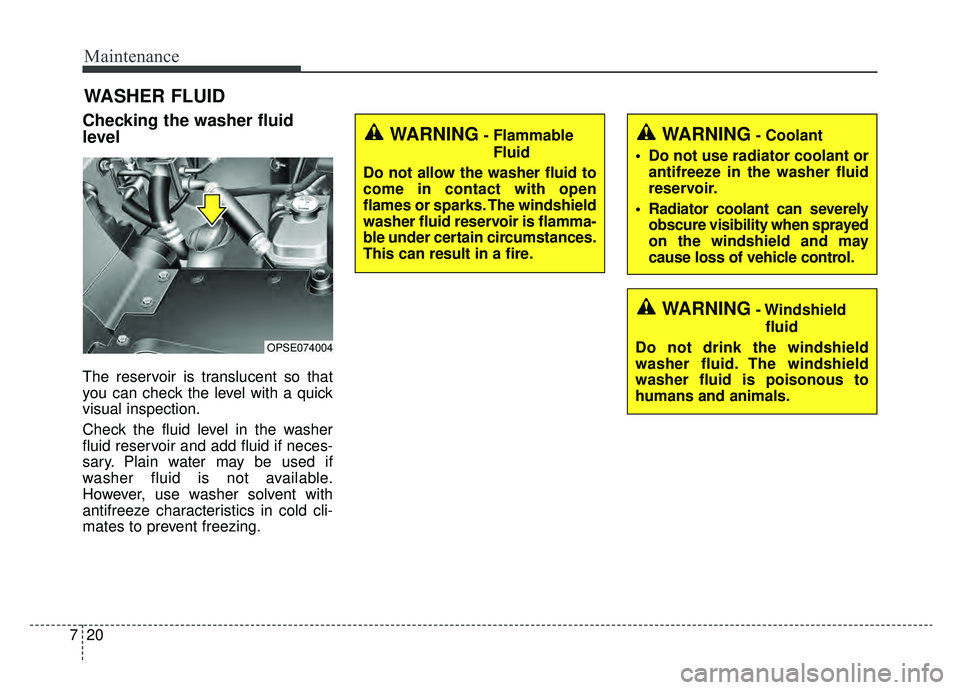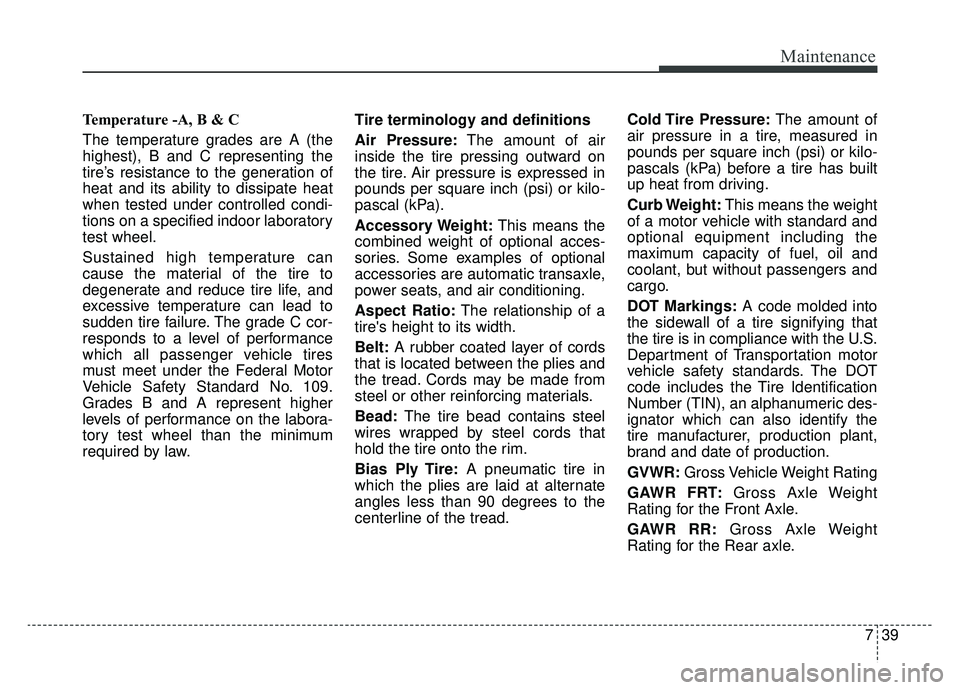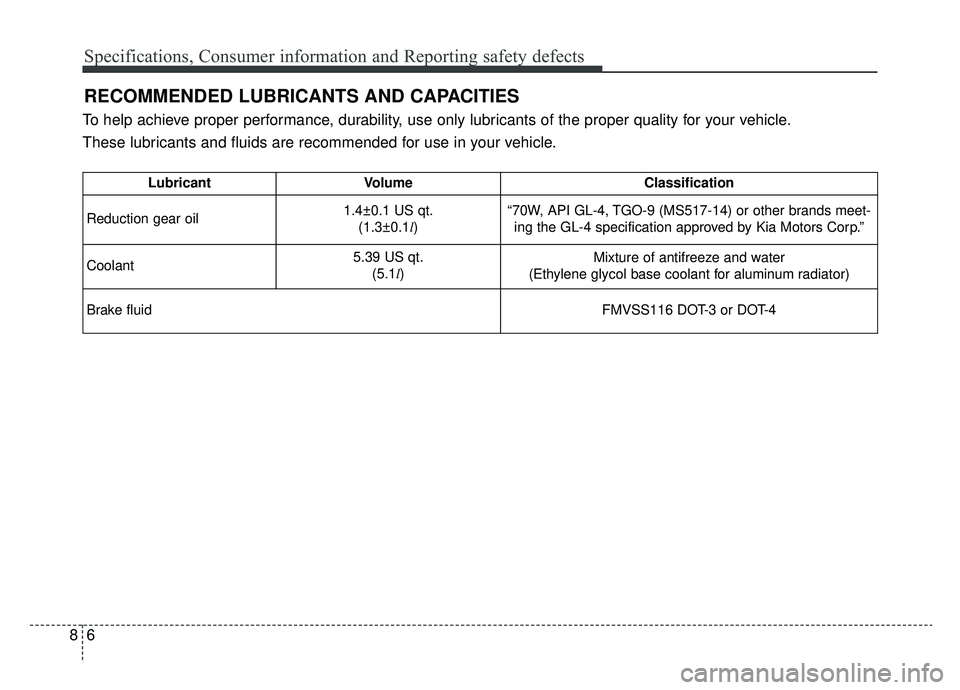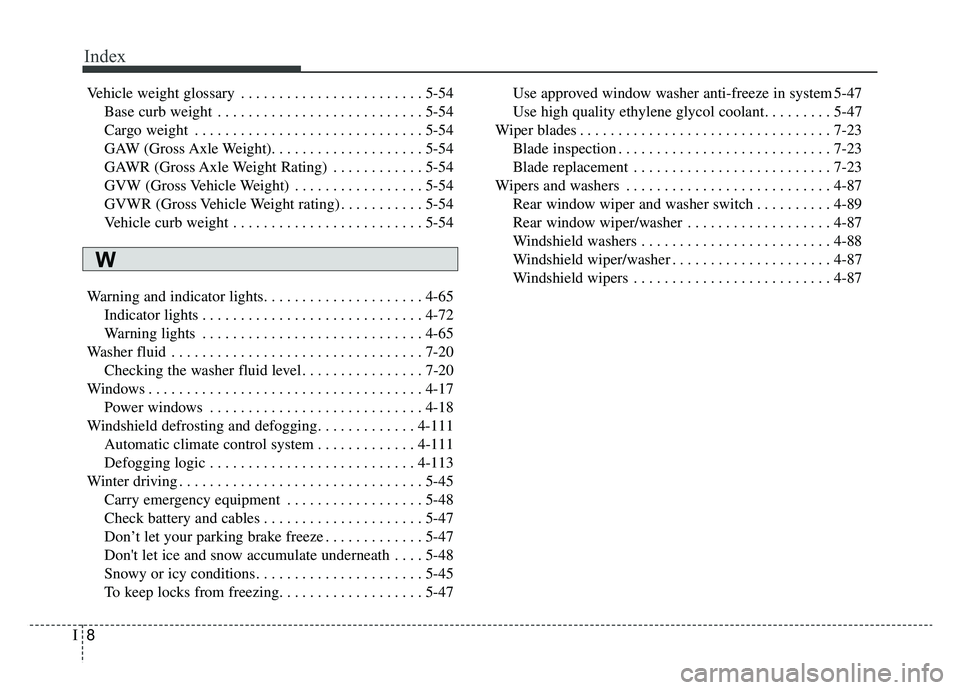2019 KIA SOUL EV coolant
[x] Cancel search: coolantPage 378 of 455

Maintenance
20
7
WASHER FLUID
Checking the washer fluid
level
The reservoir is translucent so that
you can check the level with a quick
visual inspection.
Check the fluid level in the washer
fluid reservoir and add fluid if neces-
sary. Plain water may be used if
washer fluid is not available.
However, use washer solvent with
antifreeze characteristics in cold cli-
mates to prevent freezing.
OPSE074004
WARNING- Flammable
Fluid
Do not allow the washer fluid to
come in contact with open
flames or sparks. The windshield
washer fluid reservoir is flamma-
ble under certain circumstances.
This can result in a fire.WARNING- Coolant
Do not use radiator coolant or antifreeze in the washer fluid
reservoir.
Radiator coolant can severely obscure visibility when sprayed
on the windshield and may
cause loss of vehicle control.
WARNING- Windshield
fluid
Do not drink the windshield
washer fluid. The windshield
washer fluid is poisonous to
humans and animals.
Page 397 of 455

739
Maintenance
Temperature -A, B & C
The temperature grades are A (the
highest), B and C representing the
tire’s resistance to the generation of
heat and its ability to dissipate heat
when tested under controlled condi-
tions on a specified indoor laboratory
test wheel.
Sustained high temperature can
cause the material of the tire to
degenerate and reduce tire life, and
excessive temperature can lead to
sudden tire failure. The grade C cor-
responds to a level of performance
which all passenger vehicle tires
must meet under the Federal Motor
Vehicle Safety Standard No. 109.
Grades B and A represent higher
levels of performance on the labora-
tory test wheel than the minimum
required by law.Tire terminology and definitions
Air Pressure:
The amount of air
inside the tire pressing outward on
the tire. Air pressure is expressed in
pounds per square inch (psi) or kilo-
pascal (kPa).
Accessory Weight: This means the
combined weight of optional acces-
sories. Some examples of optional
accessories are automatic transaxle,
power seats, and air conditioning.
Aspect Ratio: The relationship of a
tire's height to its width.
Belt: A rubber coated layer of cords
that is located between the plies and
the tread. Cords may be made from
steel or other reinforcing materials.
Bead: The tire bead contains steel
wires wrapped by steel cords that
hold the tire onto the rim.
Bias Ply Tire: A pneumatic tire in
which the plies are laid at alternate
angles less than 90 degrees to the
centerline of the tread. Cold Tire Pressure:
The amount of
air pressure in a tire, measured in
pounds per square inch (psi) or kilo-
pascals (kPa) before a tire has built
up heat from driving.
Curb Weight: This means the weight
of a motor vehicle with standard and
optional equipment including the
maximum capacity of fuel, oil and
coolant, but without passengers and
cargo.
DOT Markings: A code molded into
the sidewall of a tire signifying that
the tire is in compliance with the U.S.
Department of Transportation motor
vehicle safety standards. The DOT
code includes the Tire Identification
Number (TIN), an alphanumeric des-
ignator which can also identify the
tire manufacturer, production plant,
brand and date of production.
GVWR: Gross Vehicle Weight Rating
GAWR FRT: Gross Axle Weight
Rating for the Front Axle.
GAWR RR: Gross Axle Weight
Rating for the Rear axle.
Page 438 of 455

Specifications, Consumer information and Reporting safety defects
68
LubricantVolume Classification
Reduction gear oil 1.4±0.1 US qt.
(1.3±0.1l) “70W, API GL-4, TGO-9 (MS517-14) or other brands meet-
ing the GL-4 specification approved by Kia Motors Corp.”
Coolant 5.39 US qt.
(5.1l) Mixture of antifreeze and water
(Ethylene glycol base coolant for aluminum radiator)
Brake fluid FMVSS116 DOT-3 or DOT-4
RECOMMENDED LUBRICANTS AND CAPACITIES
To help achieve proper performance, durability, use only lubricants of the proper quality for your vehicle.
These lubricants and fluids are recommended for use in your vehicle.
Page 449 of 455

I3
Index
Brake system. . . . . . . . . . . . . . . . . . . . . . . . . . . . . . . . . 5-17Anti-lock Brake System (ABS) . . . . . . . . . . . . . . . . 5-23
Electronic Parking Brake (EPB) . . . . . . . . . . . . . . . 5-19
Electronic Stability Control (ESC) . . . . . . . . . . . . . 5-25
Good braking practices . . . . . . . . . . . . . . . . . . . . . . 5-31
Hill-start Assist Control (HAC) . . . . . . . . . . . . . . . . 5-60
Power brakes . . . . . . . . . . . . . . . . . . . . . . . . . . . . . . 5-17
Vehicle Stability Management (VSM) . . . . . . . . . . . 5-29
Bulb wattage . . . . . . . . . . . . . . . . . . . . . . . . . . . . . . . . . . 8-4
California perchlorate notice . . . . . . . . . . . . . . . . . . . . 7-74
Child restraint system . . . . . . . . . . . . . . . . . . . . . . . . . . 3-26 Lower anchor system . . . . . . . . . . . . . . . . . . . . . . . . 3-32
Tether anchor system . . . . . . . . . . . . . . . . . . . . . . . . 3-31
Using a child restraint system . . . . . . . . . . . . . . . . . 3-27
Clean air . . . . . . . . . . . . . . . . . . . . . . . . . . . . . . . . . . . 4-\
114
Climate control air filter . . . . . . . . . . . . . . . . . . . . . . . . 7-21 Filter inspection . . . . . . . . . . . . . . . . . . . . . . . . . . . . 7-21
Filter replacement. . . . . . . . . . . . . . . . . . . . . . . . . . . 7-21
Coolant . . . . . . . . . . . . . . . . . . . . . . . . . . . . . . . . . . . . \
. 7-15 Changing the coolant . . . . . . . . . . . . . . . . . . . . . . . . 7-17
Checking the coolant level . . . . . . . . . . . . . . . . . . . . 7-15
Cruise control system . . . . . . . . . . . . . . . . . . . . . . . . . . 5-33 Cruise control switch . . . . . . . . . . . . . . . . . . . . . . . . 5-34
To cancel cruise control . . . . . . . . . . . . . . . . . . . . . . 5-36
To decrease the cruising speed . . . . . . . . . . . . . . . . . 5-35 To increase cruise control set speed . . . . . . . . . . . . . 5-35
To resume cruising speed at more than approximately
20 mph (30 km/h) . . . . . . . . . . . . . . . . . . . . . . . . . 5-36
To set cruise control speed . . . . . . . . . . . . . . . . . . . . 5-34
To temporarily accelerate with the cruise control on . 5-35
To turn cruise control off . . . . . . . . . . . . . . . . . . . . . 5-37
Declaration of Conformity . . . . . . . . . . . . . . . . . . . . . 4-141 FCC . . . . . . . . . . . . . . . . . . . . . . . . . . . . . . . . . . . . \
4-141
Defroster . . . . . . . . . . . . . . . . . . . . . . . . . . . . . . . . . . . . \
4-93 Rear window defroster . . . . . . . . . . . . . . . . . . . . . . . 4-93
Dimensions . . . . . . . . . . . . . . . . . . . . . . . . . . . . . . . . . . . 8-\
2
Door locks. . . . . . . . . . . . . . . . . . . . . . . . . . . . . . . . . . . 4-\
10 Auto door lock/unlock feature . . . . . . . . . . . . . . . . . 4-13
Child-protector rear door lock . . . . . . . . . . . . . . . . . 4-13
Impact sensing door unlock system . . . . . . . . . . . . . 4-13
Operating door locks from inside the vehicle . . . . . 4-11
Operating door locks from outside the vehicle . . . . 4-10
Speed sensing door lock system . . . . . . . . . . . . . . . 4-13
Economical operation . . . . . . . . . . . . . . . . . . . . . . . . . . 5-38
Emergency starting . . . . . . . . . . . . . . . . . . . . . . . . . . . . . 6-5 Jump starting . . . . . . . . . . . . . . . . . . . . . . . . . . . . . . . 6-5
Push-starting . . . . . . . . . . . . . . . . . . . . . . . . . . . . . . . . 6-7
C
D
E
Page 454 of 455

Index
8I
Vehicle weight glossary . . . . . . . . . . . . . . . . . . . . . . . . 5-54Base curb weight . . . . . . . . . . . . . . . . . . . . . . . . . . . 5-54
Cargo weight . . . . . . . . . . . . . . . . . . . . . . . . . . . . . . 5-54
GAW (Gross Axle Weight). . . . . . . . . . . . . . . . . . . . 5-54
GAWR (Gross Axle Weight Rating) . . . . . . . . . . . . 5-54
GVW (Gross Vehicle Weight) . . . . . . . . . . . . . . . . . 5-54
GVWR (Gross Vehicle Weight rating) . . . . . . . . . . . 5-54
Vehicle curb weight . . . . . . . . . . . . . . . . . . . . . . . . . 5-54
Warning and indicator lights. . . . . . . . . . . . . . . . . . . . . 4-65 Indicator lights . . . . . . . . . . . . . . . . . . . . . . . . . . . . . 4-72
Warning lights . . . . . . . . . . . . . . . . . . . . . . . . . . . . . 4-65
Washer fluid . . . . . . . . . . . . . . . . . . . . . . . . . . . . . . . . . 7-20 Checking the washer fluid level . . . . . . . . . . . . . . . . 7-20
Windows . . . . . . . . . . . . . . . . . . . . . . . . . . . . . . . . . . . . \
4-17 Power windows . . . . . . . . . . . . . . . . . . . . . . . . . . . . 4-18
Windshield defrosting and defogging. . . . . . . . . . . . . 4-111 Automatic climate control system . . . . . . . . . . . . . 4-111
Defogging logic . . . . . . . . . . . . . . . . . . . . . . . . . . . 4-113
Winter driving . . . . . . . . . . . . . . . . . . . . . . . . . . . . . . . . 5-45 Carry emergency equipment . . . . . . . . . . . . . . . . . . 5-48
Check battery and cables . . . . . . . . . . . . . . . . . . . . . 5-47
Don’t let your parking brake freeze . . . . . . . . . . . . . 5-47
Don't let ice and snow accumulate underneath . . . . 5-48
Snowy or icy conditions . . . . . . . . . . . . . . . . . . . . . . 5-45
To keep locks from freezing. . . . . . . . . . . . . . . . . . . 5-47 Use approved window washer anti-freeze in system 5-47
Use high quality ethylene glycol coolant. . . . . . . . . 5-47
Wiper blades . . . . . . . . . . . . . . . . . . . . . . . . . . . . . . . . . 7-23 Blade inspection . . . . . . . . . . . . . . . . . . . . . . . . . . . . 7-23
Blade replacement . . . . . . . . . . . . . . . . . . . . . . . . . . 7-23
Wipers and washers . . . . . . . . . . . . . . . . . . . . . . . . . . . 4-87 Rear window wiper and washer switch . . . . . . . . . . 4-89
Rear window wiper/washer . . . . . . . . . . . . . . . . . . . 4-87
Windshield washers . . . . . . . . . . . . . . . . . . . . . . . . . 4-88
Windshield wiper/washer . . . . . . . . . . . . . . . . . . . . . 4-87
Windshield wipers . . . . . . . . . . . . . . . . . . . . . . . . . . 4-87
W